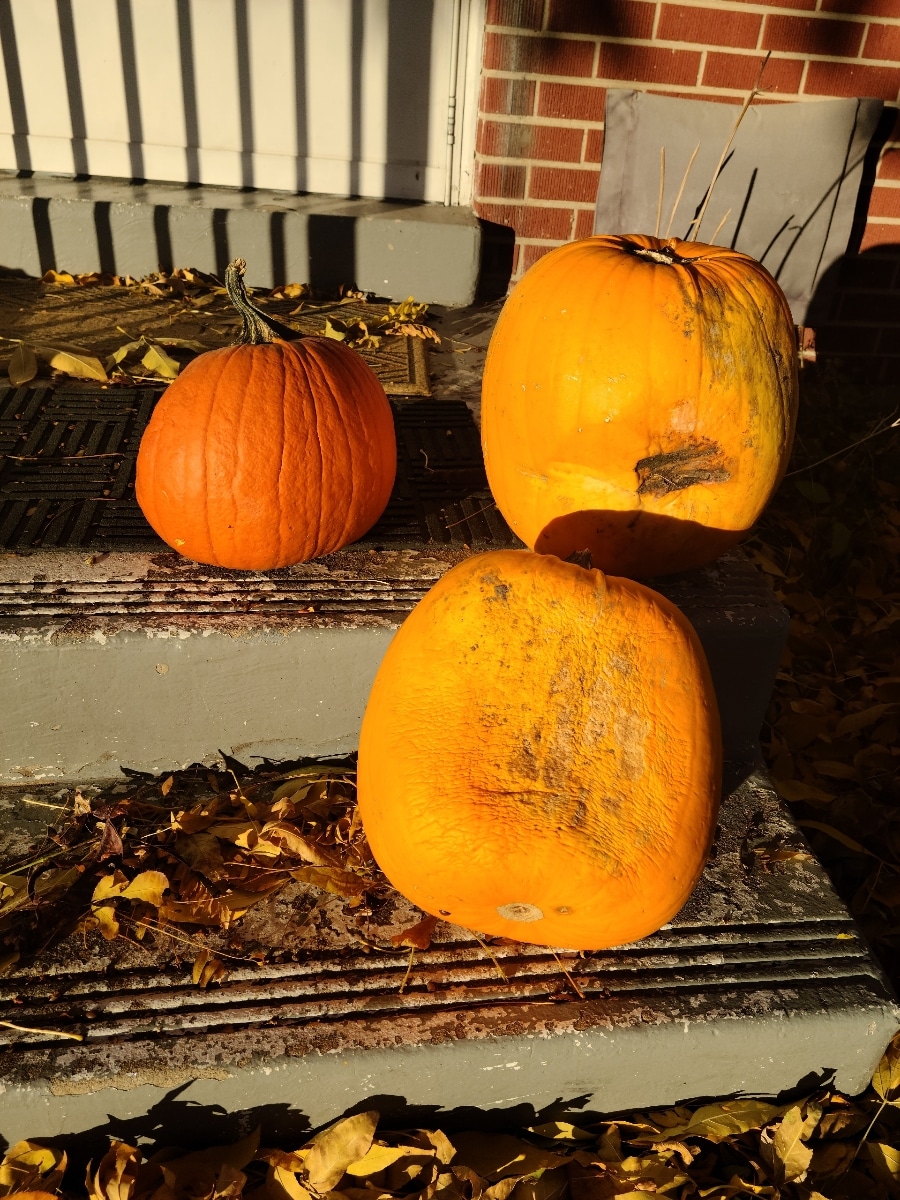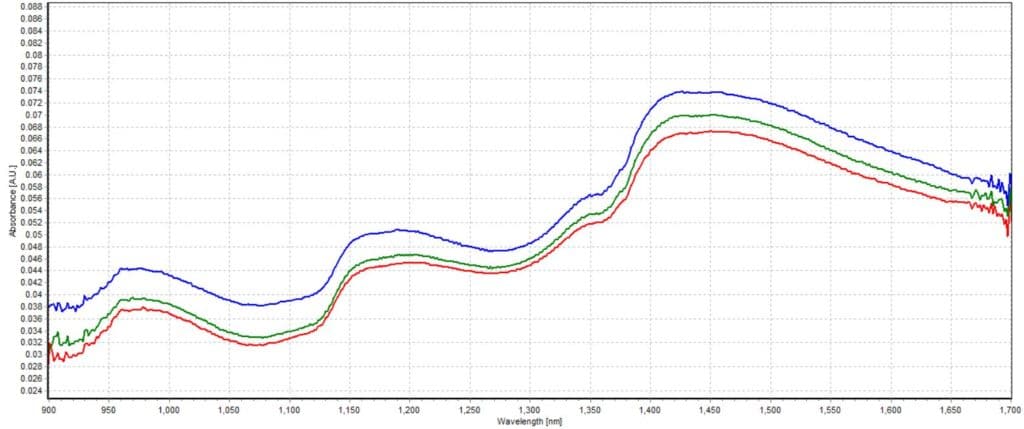How Rotten is Your Pumpkin?
Conducted by: David Ademe, Avantes Inc.
Theme: Agriculture
Background/Applications:
Absorption and reflection measurements can be used to determine the freshness of various crops, from grains to fruits and vegetables. NIR spectroscopy is leading the way for the future of agriculture and food production for both qualitative and quantitative measurements. In this experiment, we will be measuring the quality of several different pumpkins, which display different surface textures and freshness qualities.

Figure 1: The setup for the experiment.
Description of System:
A halogen light source is ideal for absorption measurements because of its power and spectral output in the NIR range, which is the wavelength range many researchers use in agriculture to study and characterize crops. The halogen light source used in this testing is integrated within our Avantes integrating sphere, an Avantes AvaSphere-50-LS-HAL. This integrating sphere and light source combination provides an excellent reading of reflection and absorption data across a larger surface when compared to a reflection probe. This reflection sphere has a 10 mm port as compared with a spot size of at most a few mm for a reflection probe. The larger sampling area provides for a more homogenous measurement on a biological sample such as a piece of fruit or a pumpkin in this case. The AvaSphere-50-LS-HAL also comes standard with an external power control for the light source enabling remote power cycling. The integrating sphere is connected via an SMA terminated fiber cable (600 micron core) to an AvaSpec-NIR512-1.7-HSC-EVO.
A xenon source may be used for agriculture measurements as well. However, it is important to utilize a higher number of averages during the measurement process as it is a pulsed light source which requires a higher averaging in order to achieve a stable output. Additionally, the xenon spectra lacks the spectral power which is present in most unfiltered tungsten halogen sources so it is not suitable for most near-infrared applications above 1000 nm.
The AvaSpec-NIR512-1.7-HSC-EVO is equipped with thermoelectric, Peltier-cooled 512-pixel InGaAs detector which supports cooling down to -25°C against ambient. The AvaSpec-NIR256/512-1.7-HSC-EVO spectrometers pair the same trusted InGaAs array detectors with our ultra-low-noise electronics board, featuring a USB3 and Giga-Ethernet connection port. The instruments are equipped standard with a Replaceable Slit allowing for users to change them for higher throughput or resolution. Digital and analog I/O ports enable external triggering and control over external devices. It is possible to select from two distinct software-controlled gain-setting modes: high-sensitivity mode (HS, default) and the low-noise mode (LN). Cooling ensures optimal noise control, even at longer integration times. All NIR-1.7 instruments are available with a choice of several different gratings, making it possible to choose the bandwidth fitting your application.
 Description of Methodology:
Description of Methodology:
For this experiment, the Avantes software AvaSoft was utilized. Within AvaSoft, there are various modules for different types of spectroscopic measurements. One of the modules in AvaSoft is Absorbance Mode, which is specifically designed to collect absorbance-related data.
The spectrometer will be used to measure the absorbance spectrum of the surface of several pumpkins. A white WS-2 tile will be placed on the port of the integrating sphere to optimize the integration time and averaging the spectrometer. This tile will then serve as a reference for collecting the absorbance spectrum of each of the four samples.
It is important to note that diffuse reflectance will be measured in this experiment and not specular reflectance. Diffuse reflectance refers to a process whereby the sample is diffusely illuminated and the reflected scattered light is collected at a wide range of angles. Because of the diffusing characteristics of our sample surface, pumpkin skin, the integrating sphere is critical to collecting the scattered reflected light. Spectral reflectance refers to the phenomenon we see when looking at a mirror. The angle of reflection of the light is equivalent to the angle of incidence. Materials and surfaces that we perceive with a matte coating exhibit diffuse reflectance, whereas samples with a glossy texture display a combination of diffuse and specular properties. Mirrors are an excellent example of a purely specular reflective material.
Each of the sample pumpkins had noticeable areas of rot and other areas of firm or normal tissue. The pumpkin samples were measured on both the normal and rotted areas to see if detectable spectral differences could be observed. Below are the results of the tests. Figure 1 shows the absorbance spectrum of the normal pumpkin tissue spots. Figure 2 shows the absorbance spectrum of the rotted areas.
Test Data and Results:
Analysis:
The three pumpkins have very similar NIR spectra on the normal parts of their surfaces. The water absorbance bands at 970 nm (10300 cm−1), 1200 nm (8333 cm-1) and 1450 nm (6896 cm-1) are clearly observable.
The spots of the pumpkins that are rotted display observably different spectra. The water absorbance characteristics are clearly influenced by the deterioration of the pumpkin tissue. This spectra is a great example of how spectroscopy can be used to identify the quality of produce. Fruit sorting using near-infrared spectra is a real-world application that Avantes customers are performing using our instrument.
The next steps could include developing a chemometric model for identifying the quality of the pumpkins. Spectral features can be correlated to quality parameters such as ripeness to create multivariate statistical models. When future spectra are compared to this model, the quality of the pumpkins can be determined. Avantes spectrometers are routinely used in these sorts of applications. A chemometric model can also be useful in all aspects of the agriculture industry to develop models determining the freshness of food.
Conclusion:
The AvaSpec-NIR512-1.7-EVO can effectively collect reflection and absorbance data that provides useful information about agriculture products. Similar diffuse reflection measurements can be performed in the visible range (380-780 nm) for a variety of applications including material characterization, medical diagnostics and geological sampling.
 My Cart
My Cart 


